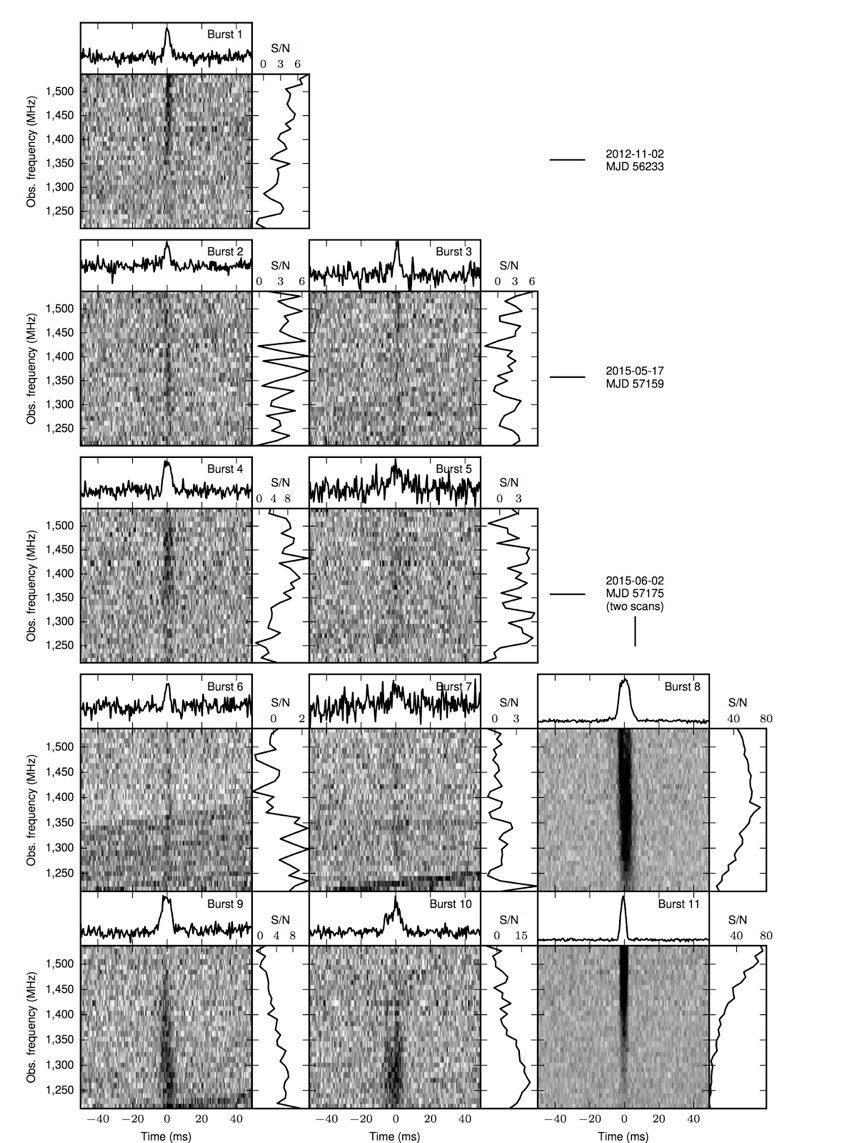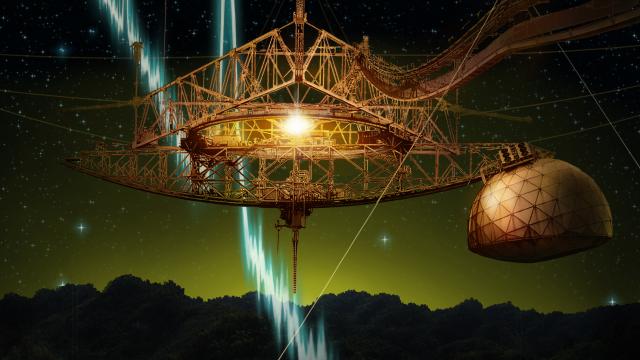Fast radio bursts, or FRBs, are a source of endless fascination. But despite a decade of observations, not all astronomers are sure that they’re real. A study out in Nature today, which reports the very first recurring FRB, is now causing lingering scepticism to evaporate.
“I think this is pretty huge,” Peter Williams, an astronomer at Harvard’s Center for Astrophysics who was not involved with the study, told Gizmodo. “For a while, I wasn’t sure these things were genuinely astrophysical. This paper settles the question.”
And Williams is not one to take splashy new claims about FRBs — high energy radio pulses of unknown origin, which flit across the sky for a fraction of a second — lightly. In fact, he’s spent the last week raising major doubts about another recent study, which, as Gizmodo and other outlets reported, claimed to have pinpointed the location of an FRB in space for the first time.
The repeating burst reported in Nature, FRB 121102, was detected by an international team of astronomers using the most sensitive radio telescope in the world, the Arecibo Observatory in Puerto Rico. Not only is 121102 the first instance of a recurrent FRB, it’s the first FRB detected with anything other than the Parkes Observatory in Australia. (There are 16 other published FRBs to date.)
“Parkes has wide field of view but low sensitivity,” Jason Hessels, a researcher at the Netherlands Institute for Radio Astronomy and co-author on the new study, told Gizmodo. “Arecibo has small field of view, but once you find something, you can dig much more deeply.”
Hessels and his collaborators spotted FRB 121102 in 2012 during a survey of pulsars, rapidly-rotating stellar relics that emit beams of radio energy. “Conventional wisdom was that this source wasn’t going to repeat,” Hessels said. “But we decided to spend some time confirming that.”
Hessels’ team obtained additional observations last spring, and were amazed to discover not just one or two, but ten additional radio bursts. These bursts occurred in the same patch of sky, and had the same “dispersion measure” — a metric that tells astronomers how far radio waves have travelled to reach our receivers. “This unambiguously identifies FRB 121102 as repeating,” Hessels and his co-authors write.

11 bursts seen from FRB 121102, shown as a function of radio observing frequency. Image Credit: Paul Scholz
And that, in turn, has big implications for what could be causing the mysterious energy bursts, which have been attributed to everything from pulsars to merging neutron stars to supernovae.
“Quite simply, whatever is producing repeating [FRBs] isn’t being destroyed,” Hessels said. “This is a really important insight.”
But the discovery gets even more interesting. The bursts don’t come at regular intervals, but are instead clustered in time. “On one observation we saw six pulses within ten minutes,” Hessels said, “and there are many observations where we don’t see any.”
“The other really weird thing about the repeat bursts is that they have very different spectra,” he added.
So, we’re looking at a high energy and highly variable pulse that occurs at seemingly random intervals. What could be causing such an event? Hessels and his co-authors discuss one intriguing possibility: an insanely dense, rapidly rotating dead star with a magnetic field a thousand trillion times greater than the one you’re sitting in right now. Called a magnetar, this is a very special and exotic type of neutron star. If you were foolish enough to approach one in a spaceship, it’d stretch every atom in your body into a pencil-shaped rod.
According to Hessels, it’s plausible that “starquakes” — rapid reconfigurations in a neutron star’s magnetic field — could be behind the exceptional signal.
Before they can be certain, Hessels and his team need to figure out exactly where in space the FRBs are coming from. “If we can localise the signal to another galaxy and get an idea of the distance, then we really know how much energy is involved,” he said.
But nailing down the location of an FRB is no easy task, which brings us to the radio burst study published last week in Nature, which claims to have done so for the first time, linking FRB 150418 to a quiescent galaxy located six billion light years away.
Unfortunately, the team’s conclusions started to unravel over the weekend, when Williams, along with Harvard astronomer Edo Berger, found new evidence that they argue invalidate any associations between FRB 150418 and this particular location. (Much more on Williams’ new findings here.) “I’m reluctant to say we’ve debunked it yet, but I think we’ve raised questions,” Williams said.
In an email to Gizmodo, Keane declined to comment on the recent development. “We are of course aware of that piece of work by Williams & Berger, and indeed are performing our own ongoing studies,” he wrote. “When we’ve completed and fully considered those we will certainly report our findings.”
However the latest controversy shakes out, both Keane and Hessels’ studies underscore the challenges associated with trying to understand fleeting cosmic signals. But this is the scientific process, in all of its messy glory. Perhaps it will turn out that there are many different celestial phenomena — from the furious quakes of giant cosmic magnets to colliding stars — behind these elusive energy pulses. I personally can’t wait to see what we discover.
[Nature]
Artist’s concept of Arecibo telescope and its suspended support platform of radio receivers. Image Credit: Danielle Futselaar
